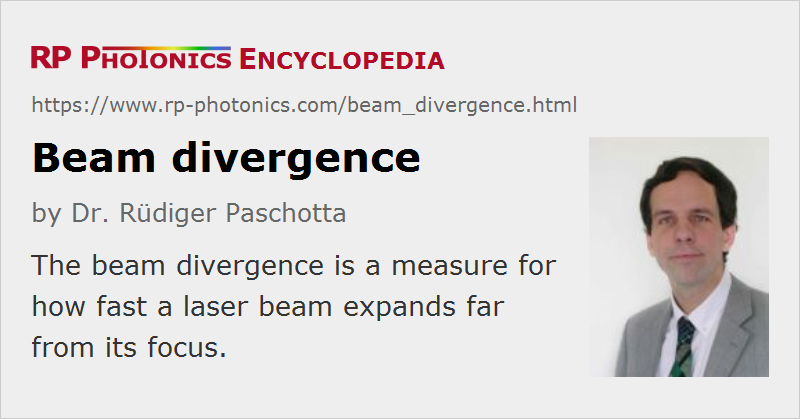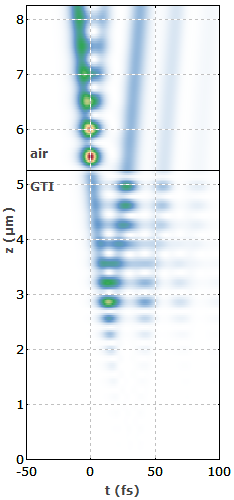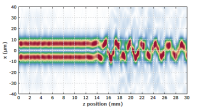Beam Divergence
Definition: a measure for how fast a laser beam expands far from its focus
German: Strahldivergenz
Formula symbol: θ
Units: °, mrad
How to cite the article; suggest additional literature
Author: Dr. Rüdiger Paschotta
The beam divergence of a laser beam is a measure for how fast the beam expands far from the beam waist, i.e., in the so-called far field. A low beam divergence can be important for applications such as pointing or free-space optical communications. Beams with very small divergence, i.e., with approximately constant beam radius over significant propagation distances, are called collimated beams; they can be generated from strongly divergence beams with beam collimators.

Some amount of divergence is unavoidable due to the general nature of waves (assuming that the light propagates in a homogeneous medium, not e.g. in a waveguide). That amount is larger for tightly focused beams. If a beam has a substantially larger beam divergence than physically possibly, it is said to have a poor beam quality. More details are given below after defining what divergence means quantitatively.
Quantitative Definitions of Beam Divergence
Different quantitative definitions are used in the literature:
- According to the most common definition, the beam divergence is the derivative of the beam radius with respect to the axial position in the far field, i.e., at a distance from the beam waist which is much larger than the Rayleigh length. This definition yields a divergence half-angle (in units of radians), and further depends on the definition of the beam radius. For Gaussian beams, the beam radius is usually defined via the point with 1/e2 times the maximum intensity. For non-Gaussian profiles, an integral formula can be used, as discussed in the article on beam radius.
- Sometimes, full angles are used instead, resulting in twice as high values.
- Instead of referring to directions with 1/e2 times the maximum intensity, as is done for the Gaussian beam radius, a full width at half-maximum (FWHM) divergence angle can be used. This is common e.g. in data sheets of laser diodes and light-emitting diodes. For Gaussian beams, this kind of full beam divergence angle is 1.18 times the half-angle divergence defined via the Gaussian beam radius (1/e2 radius).
As an example, an FWHM beam divergence angle of 30° may be specified for the fast axis of a small edge-emitting laser diode. This corresponds to a 25.4° = 0.44 rad 1/e2 half-angle divergence, and it becomes apparent that for collimating such a beam without truncating it one would require a lens with a fairly high numerical aperture of e.g. 0.6. Highly divergent (or convergent) beams also require carefully designed optics to avoid beam quality degradation by spherical aberrations.
Divergence of Gaussian Beams and Beams with Poor Beam Quality
For a diffraction-limited Gaussian beam, the 1/e2 beam divergence half-angle is λ / (π w0), where λ is the wavelength (in the medium) and w0 the beam radius at the beam waist. This equation is based on the paraxial approximation, and is thus valid only for beams with moderately strong divergence.
A higher beam divergence for a given beam radius, i.e., a higher beam parameter product, is related to an inferior beam quality, which essentially means a lower potential for focusing the beam to a very small spot. If the beam quality is characterized with a certain M2 factor, the divergence half-angle is
As an example, a 1064-nm beam from a Nd:YAG laser with perfect beam quality (M2 = 1) and a beam radius of 1 mm in the focus has a half-angle divergence of only 0.34 mrad = 0.019°.
Spatial Fourier Transforms
For obtaining the far field profile a beam, one may apply a two-dimensional transverse spatial Fourier transform to the complex electric field of a laser beam (→ Fourier optics). Effectively this means that the beam is considered as a superposition of plane waves, and the Fourier transform indicates the amplitudes and phases of all plane-wave components. For propagation in free space, only the phase values change; it is thus easy to calculate propagation over large distances in free space, or alternatively in a homogeneous optical medium.
The width, measured e.g. as the root-mean-squared (r.m.s.) width, of the spatial Fourier transform can be directly related to the beam divergence. This means that the beam divergence (and in fact the full beam propagation) can be calculated from the transverse complex amplitude profile of the beam at any one position along the beam axis, assuming that the beam propagates in a homogeneous medium (e.g. in air).
Measurement of Beam Divergence
For the measurement of beam divergence, one usually measures the beam caustic, i.e., the beam radius at different positions, using e.g. a beam profiler.
It is also possible to derive the beam divergence from the complex amplitude profile of the beam in a single plane, as described above. Such data can be obtained e.g. with a Shack–Hartmann wavefront sensor.
Questions and Comments from Users
2020-05-21
What are some typical beam divergence values used for long distance satellite communications?
Answer from the author:
That differs between different usage scenarios. For example, if you want to reach a satellite with a sender on Earth, you can use a relatively large optical system, e.g. a with a 1-m diameter, and then achieve a correspondingly small beam divergence of the order of a microradian. For optical communications between different satellites, or for the backlink of a satellite, you typically need to use smaller optics and thus have a correspondingly larger beam divergence.
The size of the required optics is often the limiting factor. Another factor may be the highly precise orientation required for working with low-divergence beams.
Here you can submit questions and comments. As far as they get accepted by the author, they will appear above this paragraph together with the author’s answer. The author will decide on acceptance based on certain criteria. Essentially, the issue must be of sufficiently broad interest.
Please do not enter personal data here; we would otherwise delete it soon. (See also our privacy declaration.) If you wish to receive personal feedback or consultancy from the author, please contact him e.g. via e-mail.
By submitting the information, you give your consent to the potential publication of your inputs on our website according to our rules. (If you later retract your consent, we will delete those inputs.) As your inputs are first reviewed by the author, they may be published with some delay.
See also: beam radius, laser beams, collimated beams, beam parameter product, beam quality, beam pointing fluctuations, beam profilers, free-space optical communications, The Photonics Spotlight 2007-07-11
and other articles in the category general optics

This encyclopedia is authored by Dr. Rüdiger Paschotta, the founder and executive of RP Photonics Consulting GmbH. How about a tailored training course from this distinguished expert at your location? Contact RP Photonics to find out how his technical consulting services (e.g. product designs, problem solving, independent evaluations, training) and software could become very valuable for your business!
 |












2020-04-16
If I know the emitting area (2 μm × 1 μm) of a laser diode; how to calculate the divergence angle for that?
Answer from the author:
From the emitting area alone you cannot do that; the transverse shape of the complex amplitude profile is also relevant. For a rough estimate, you may assume a Gaussian beam with w = 1 μm for the wider direction, for example, assuming a single-mode profile.